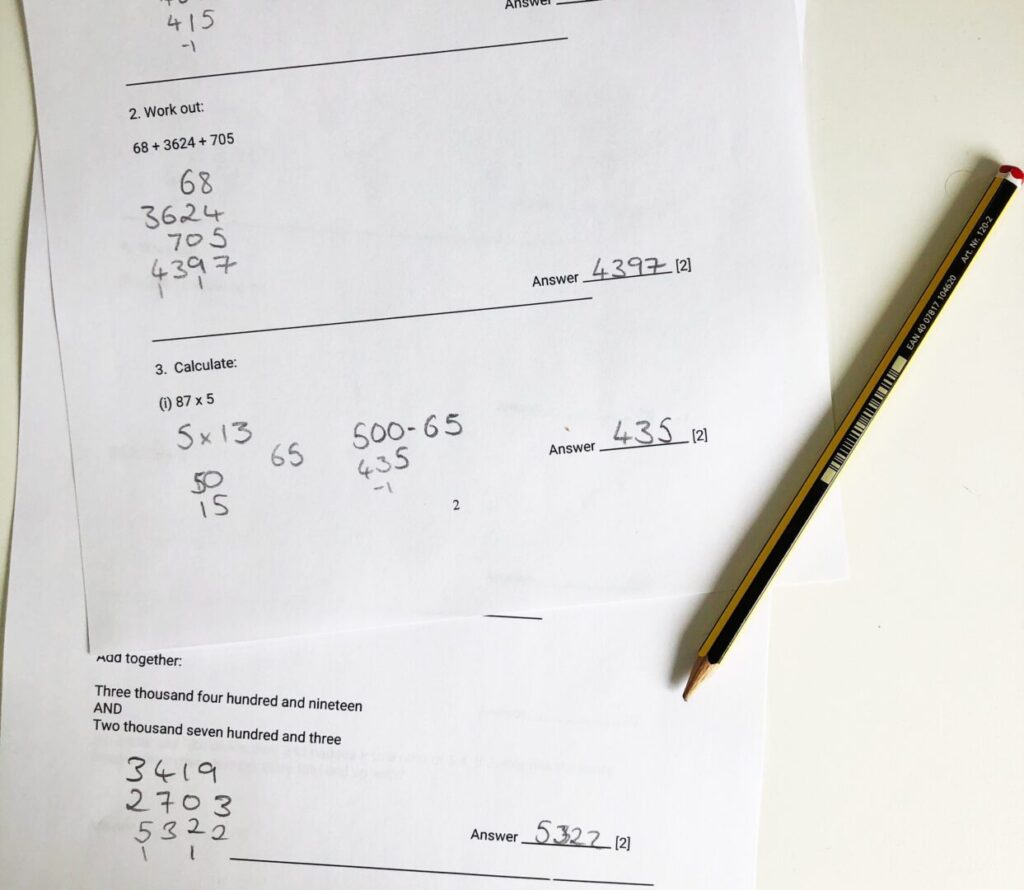What is on the 11 Plus Maths Exam?
What is on the Maths syllabus and how can you prepare your child for the exam? Read on for everything you need to know and our top tips.

With the 11 plus Maths exam covering the entire Year 6 Maths syllabus, an early start on preparation is vital. It is vital that parents understand that their children sitting the exam must know the Maths syllabus.
11 Plus Maths Exam Overview
The 11 plus Maths exam covers the entire KS2/ Year 6 National Curriculum syllabus, so it is important to start exam preparation early. There is a wide range of topics that will come up on the exam too and is advanced in level. Therefore, knowing the Maths syllabus is vital to your child succeeding in this area.
Taking the Maths exam is a key part to the application and entry process to a Grammar school or Independent school.
The 11 Plus Syllabus
Number and the number system
Place value, ordering and rounding
- Read and write whole numbers in figures and words, and know what each digit represents up to and including millions
- Multiply and divide decimals to 1 decimal place mentally by 10 or 100, and divide integers by 1000
- Round an integer to the nearest 10, 100 or 1000
- Find the difference between a positive and negative integer, or two negative integers, in context such a temperature or the number line (eg. Find the difference between 7 degrees C and -3 degrees C)
- Order a set of positive and negative integers.
Properties of numbers and number sequences
- Recognise sequences formed by counting from any number in steps of constant size, extending beyond zero when counting back (eg. Counting on in steps of 0.1, 0.2, 0.25, 0.5 and then back)
- Make general statements about odd and even numbers, including outcomes of sums, differences and products
- Recognise multiples up to 12 x 12
- Know and apply simple tests of divisibility by 2,3,4,5,6,7,8,9,10, 25 or 100
- Know square numbers to at least 12 x 12
- Recognise prime numbers to at least 100, and recognise them as a sequence
- Find all pairs of factors of any number to 100
- Recognise triangular numbers
- Prime factors. Recognise and express any number as the product of prime factors.
Fractions, decimals, percentages, ratio and proportion
- Change a fraction such as 33/8 to the equivalent mixed numbers and vice versa
- Recognise relationships between fractions (for example 1/10 is ten times 1/100, and 1/16 is half of 1/8)
- Reduce a fraction to its simplest form by cancelling common factors in the numerator and denominator, this will test their rules of divisibility
- Order fractions by converting them to fractions with a common denominator
- Adding and subtracting fractions and mixed numbers with different denominators, the numerators and denominators will be less than 10
- Find a fraction of whole number quantities
- Compare ratios and write ratios in their simplest form
- Solve simple problems involving proportion
- Use decimal notation for tenths and hundredths in calculations, and tenths, hundredths and thousandths when recording measurements
- Know what each digit represents in a number up to 3 decimal places
- Give a decimal lying halfway between 2 others (eg. Between 3.4 and 3.5)
- Order a mixed set of numbers or measurements with up to 3 decimal places
- Round a number with 2 decimal places to the nearest tenth or the nearest whole number
- Recognise the equivalence between the decimal and fraction forms of tenths, hundredths, thousandths, halves, quarters and fifths
- Understand percentage as the number of parts in every 100
- Find percentages of whole number quantities (eg. 1% to 10%, all multiples of 10% up to 100%, 25% and 75%). All calculations will be within their mental arithmetic range
- Convert decimals (tenths and hundredths) to percentages and vice versa
- Convert fractions (tenths, hundredths, halves, quarters and fifths) to percentages and vice versa.
Calculations
Pencil and paper procedures (+ and -)
- Use informal pencil and paper methods to support, record or explain addition and subtraction.
- Written methods should be extended to: Column addition and subtraction of two integers less than a million.
- Addition of more than 2 integers less than a million
- Column addition and subtraction of numbers involving decimals
- Addition and subtraction of fractions and mixed numbers with different denominators, the numerators and denominators will be less than 10.
Pencil and paper procedures (x and ÷)
- Approximate first, using informal pencil and paper methods to support, record or explain multiplications and divisions
- Written methods should be extended to: Short multiplication of thousands, hundreds, tens and units
- Short multiplication of numbers involving decimals
- Long multiplications of hundreds, tens and units by tens and units
- Short division of hundreds, tens and units by units with mixed number answer
- Multiplication and division of fraction by integer, multiplication and division of integer by decimal, and long division by hundreds, tens, units by tens and units.
Checking results of calculations
- Check the sum of several numbers by adding in reverse order
- Check with an equivalent calculation
- Estimate by approximating (round to the nearest tenth, whole number, 10, 100, 1000) then check the results
- Use the knowledge of the sums, differences and products of odd and even numbers
- Check with inverse operations
- Use test of divisibility
- Rapid recall of facts and mental strategies.
Solving problems
- Choose and use appropriate number operations to solve problems
- Solve mathematical problems or puzzles, recognise and explain patterns and relationships, generalise and predict
- Make and investigate a general statement about familiar numbers or shapes by finding examples that satisfy it
- Identify and use appropriate operations (including combinations of operations) to solve word problems involving numbers and quantities eg. Money or measure including time
- Candidates must be able to explain methods and reasoning
- Formal algebra, so no simplifying of expressions, substitution into formulae or solving equations.
Handling Data
- Solve a problem by extracting data in tables, graphs, charts and diagrams. (frequency tables and diagrams, grouping data, construct and interpret simple line graphs, interpret Bar charts and Pie charts
- Drawing and reading information from a conversion graph
- Probability
- Measure of spread (range) and central tendency (mean , median and mode). Including finding these from a frequency table.
Measure, Shape and Space
Measure
- Use, read and write standard metric units (km, m, cm, mm, t. kg, g, l, ml, cl)
- Convert smaller to larger units and vice versa
- Have knowledge of imperial units still in use (eg, understand miles are used to measure length and pints are used to measure capacity). Know approximate conversions eg. 5 miles = 8 km
- Calculate the perimeter and area of squares, rectangles and right-angled triangles
- Calculate the perimeter and area of compound shapes (split into rectangles and right-angled triangles)
- The ability to work out durations of time, counting on and back from time (eg. If the time is 23.10 what was the time 2 ½ hours ago?)
- Read timetables accurately and convert between the 12- and 24-hour clock
- Find the volume of cuboids and solve problems related to their measurements.
Shapes and space
- Describe and visualise properties of solid shapes such as parallel or perpendicular faces or edges
- Classify triangles using criteria such as equal sides, equal angles, lines of symmetry
- Construct triangles
- Classify polygons, using criteria such as parallel sides, equal angles and equal sides
- Classify quadrilaterals, using criteria such as parallel sides, equal angles and equal sides
- Recognise and draw lines of symmetry
- Visualise 3-D shapes from 2-D drawings and identify different nets for a cube and nets for other 3D shapes
- Recognise where a shape will be after reflection in a mirror line
- Read and plot co-ordinates in all four quadrants
- Recognise, measure and estimate angles
- Calculate angles on a straight line round a point
- Reflective symmetry, rotational symmetry, rotation and translation, order of symmetry
- Bearings.
What Does The 11+ Maths Exam Include?
The Maths examination is usually one paper of 45 mins to 1 hour.
The exam tends to start with short questions testing accuracy of operations, which candidates will need to move through with speed and accuracy. Questions will include more words and become more complex as the paper goes on. Practice and exam technique will become critical to answer questions with applicable knowledge, methodology and accuracy.

The final quarter of the Maths paper often tests candidates with questions they won’t have seen before. This is where children can differentiate themselves and scholarships are won. It is vital that pupils get to this stage of the paper, having banked enough marks and with time to properly attempt some of these questions.
How is The 11 + Maths Exam Marked?
The scoring may differentiate depending on the exam board that is used. Typically, the Maths exam starts off with easier questions (often with students gaining 1–2 marks) and then progressively get more challenging.
Usually, for more complex questions, the exam board wants to see methodology and working out. Children should form good habits in their preparation to show how they are breaking down the information in the question, the steps it takes to solve the problem and how they have got to the final answer.
In the 11+ exams, there is a process called standardisation, which takes into more considerations like the child’s age, so younger students in the year group are not at a disadvantage.
11 Plus Maths Exam Tips
The key to speed in the Maths exam is secure knowledge and quick recall of times tables and number bonds. As a parent, you need to focus very hard on this in Years 4 and 5 at school and continue to regularly practice this throughout your school entrance campaign, no matter how good your child is at Maths. Your child will need to work through their Maths exam, picking up a mark a minute. It is crucial that parents and children alike realise how fast this is. You can find out more information about this by contacting our school entrance co-ordinator or speaking to one of our experienced tutors.
Remember that mathematical ability will also play a large role in your child’s Non-Verbal Reasoning score. It will also be tested in your child’s interview with mental maths and logic problems very common.
Next Steps For Exam preparation
Our expert team are on hand to help your child succeed in the 11 plus Maths exam. We have different 11 plus tutoring options and weekend classes that will suit how your child likes to learn. Early preparation to master exam technique is key – the sooner you start, the easier it is to identify any weaknesses and help your child through them.
For more information and to get started, get in touch to see how we can help your child.
Further 11 Plus Resources
London’s No.1 Tuition Agency
Media coverage
Mentor Education won Tutoring Provider of the Year at the Education Investor Awards in 2022 and 2024. We also won at the National Tutoring Awards and an Entrepreneur of the Year award in 2024. We are regularly featured in the Education Press, including School Report Magazine, the Good Schools Guide, and more.
Our Clients Journeys
Case studies
With the support of our wonderful families and the expertise of a dedicated team of school entrance, GCSE and A Level tutors, we work closely with every child to help them confidently navigate their exams. Whether it’s securing a scholarship, addressing specific learning needs, aiming for a place at a competitive school, or securing the grades for university, we’re here to guide you every step of the way.
Customers love what we do
What our parents have to say about Mentor
We are so proud of our 5 star reviews and testimonials which are a testament to the relationships our teachers build with their pupils and the success they create together.

